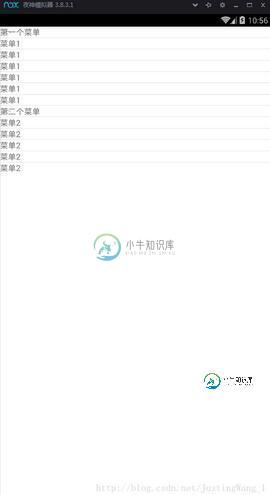Android中ExpandableListView使用示例详解
本文实例为大家分享了ExpandableListView使用示例,供大家参考,具体内容如下
MainActivity:
public class Expandable_test extends Activity {
private ExpandableListView listView;
private Map<String, List<String>> dataset = new HashMap<>();
private String[] parentList = new String[]{"第一个菜单", "第二个菜单"};
private ExpandableListViewAdpter adpter;
private Context mContext = this;
@Override
protected void onCreate(Bundle savedInstanceState) {
super.onCreate(savedInstanceState);
setContentView(R.layout.activity_expandable_test);
listView=(ExpandableListView)findViewById(R.id.expandableListViewtext);
adpter=new ExpandableListViewAdpter(this,parentList);
listView.setAdapter(adpter);
}
}
MainActivity.xml:
<LinearLayout xmlns:android="http://schemas.android.com/apk/res/android" xmlns:app="http://schemas.android.com/apk/res-auto" xmlns:tools="http://schemas.android.com/tools" android:layout_width="match_parent" android:layout_height="match_parent" tools:context="com.fae.mobile.testActivity.Expandable_test"> <ExpandableListView android:layout_width="match_parent" android:layout_height="wrap_content" android:id="@+id/expandableListViewtext"> </ExpandableListView> </LinearLayout>
ExpandableListViewAdpter:
public class ExpandableListViewAdpter extends BaseExpandableListAdapter {
private Context mContext;
private Map<String, List<String>> dataset = new HashMap<>();
private String[] parentList = new String[]{"第一个菜单", "第二个菜单"};
private String[][] chdrenList=new String[][]
{{"菜单1","菜单1","菜单1","菜单1","菜单1","菜单1"},{"菜单2","菜单2","菜单2","菜单2","菜单2"}};
public ExpandableListViewAdpter(Context context, String[] parentList){
this.mContext=context;
this.dataset=dataset;
this.parentList=parentList;
}
@Override
public int getGroupCount() {
return parentList.length;
}
@Override
public int getChildrenCount(int groupPosition) {
return chdrenList[groupPosition].length;
}
@Override
public Object getGroup(int groupPosition) {
return parentList[groupPosition];
}
@Override
public Object getChild(int groupPosition, int childPosition) {
return chdrenList[groupPosition][childPosition];
}
@Override
public long getGroupId(int groupPosition) {
return groupPosition;
}
@Override
public long getChildId(int groupPosition, int childPosition) {
return childPosition;
}
@Override
public boolean hasStableIds() {
return true;
}
@Override
public View getGroupView(int groupPosition, boolean isExpanded, View convertView, ViewGroup parent) {
GroupViewHolder holder=null;
if(convertView==null){
convertView = LayoutInflater.from(mContext).inflate(R.layout.itemlayoutexpandable, null);
holder=new GroupViewHolder();
holder.text=(TextView)convertView.findViewById(R.id.item_text);
convertView.setTag(holder);
}
else {
holder=(GroupViewHolder)convertView.getTag();
}
holder.text.setText(parentList[groupPosition]);
return convertView;
}
@Override
public View getChildView(int groupPosition, int childPosition, boolean isLastChild, View convertView, ViewGroup parent) {
ChildViewHolder holder=null;
if(convertView==null){
convertView = LayoutInflater.from(mContext).inflate(R.layout.itemlayoutexpandable, null);
holder=new ChildViewHolder();
holder.text=(TextView)convertView.findViewById(R.id.item_text);
convertView.setTag(holder);
}
else {
holder=(ChildViewHolder)convertView.getTag();
}
holder.text.setText(chdrenList[groupPosition][childPosition]);
return convertView;
}
@Override
public boolean isChildSelectable(int groupPosition, int childPosition) {
return true;
}
class GroupViewHolder {
TextView text;
}
class ChildViewHolder {
TextView text;
}
}
Item.xml:
<LinearLayout xmlns:android="http://schemas.android.com/apk/res/android" android:layout_width="match_parent" android:layout_height="match_parent"> <TextView android:layout_width="match_parent" android:layout_height="wrap_content" android:gravity="bottom" android:id="@+id/item_text"/> </LinearLayout>


以上就是本文的全部内容,希望对大家的学习有所帮助,也希望大家多多支持小牛知识库。
-
本文向大家介绍Android中ExpandableListView的用法实例,包括了Android中ExpandableListView的用法实例的使用技巧和注意事项,需要的朋友参考一下 本文实例讲述了Android中ExpandableListView的用法,ExpandableListView是android中可以实现下拉list的一个控件,具体的实现方法如下: 首先:在layout的xml文
-
本文向大家介绍Android 中使用ExpandableListView 实现分组的实例,包括了Android 中使用ExpandableListView 实现分组的实例的使用技巧和注意事项,需要的朋友参考一下 Android 中使用ExpandableListView 实现分组 一个视图显示垂直滚动两级列表中的条目。这不同于列表视图,允许两个层次,类似于QQ的好友分组。要实现这个效果的整体思路
-
本文向大家介绍Android ExpandableListView展开列表控件使用实例,包括了Android ExpandableListView展开列表控件使用实例的使用技巧和注意事项,需要的朋友参考一下 你是否觉得手机QQ上的好友列表那个控件非常棒? 不是..... 那也没关系,学多一点知识对自己也有益无害。 那么我们就开始吧。 展开型列表控件, 原名ExpandableListView 是普
-
本文向大家介绍分享Android中ExpandableListView控件使用教程,包括了分享Android中ExpandableListView控件使用教程的使用技巧和注意事项,需要的朋友参考一下 本文采用一个Demo来展示Android中ExpandableListView控件的使用,如如何在组/子ListView中绑定数据源。直接上代码如下: 程序结构图: layout目录下的 main.x
-
本文向大家介绍Android 进度条使用详解及示例代码,包括了Android 进度条使用详解及示例代码的使用技巧和注意事项,需要的朋友参考一下 在这里,总结一下loading进度条的使用简单总结一下。 一、说起进度条,必须说说条形进度条,经常都会使用到嘛,特别是下载文件进度等等,还有像腾讯QQ安装进度条一样,有个进度总给人良好的用户体验。 先来找图看看,做这个图完成不用图片就可以做到了。 看下xm
-
本文向大家介绍详解Android中使用Notification实现进度通知栏(示例三),包括了详解Android中使用Notification实现进度通知栏(示例三)的使用技巧和注意事项,需要的朋友参考一下 我们在使用APP的过程中,软件会偶尔提示我们进行版本更新,我们点击确认更新后,会在通知栏显示下载更新进度(已知长度的进度条)以及安装情况(不确定进度条),这就是我们今天要实现的功能。实现效果如

